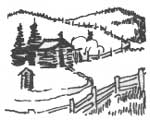|
The Clearwater Story: A History of the Clearwater National Forest |

|

Chapter 11
June 11 Claims
When the Forest Reserves were proclaimed, the land was withdrawn from all forms of entry except mineral, subject to all valid claims. Thus, further homesteading was barred, but those living on the land under what was known as squatters' rights could remain on their claims and eventually obtain patent.
Bringing homesteading to a sudden halt on such large areas was not in accordance with long established customs in the West, nor did it meet with the approval of local people. The Forest Reserves were condemned as unnecessary, and an infringement on free enterprise. Forest Supervisors and Rangers became very unpopular. Such a big protest went up over the homesteading issue that it was necessary to find a means to compromise on some ground that would be acceptable to the opposing forces. This resulted in the Act of June 11, 1906, from which came the term June 11 claims.
This act provided that any lands classified by the Secretary of Agriculture as chiefly valuable for agriculture were to be opened to homestead entry. This placed upon the Department of Agriculture the burden of examining all National Forest lands and listing for homestead entry any chiefly valuable for farming.
To do this the Rangers went over the forest and on a map drew a sketch of any area that was large and flat enough that it could possibly be considered as a potential farm unit. This was called an extensive land classification survey. It narrowed the lands to be considered to scattered tracts along creek and river bottoms.
This work was followed by an intensive survey which was conducted by college graduates in agriculture who were not employees of the Forest Service. These men carefully examined the lands the Ranger had mapped as possible homesteads. They considered the quality of the soil, weather conditions, irrigation possibilities, etc. Their recommendations were final. However to avoid controversy they were instructed to list the land if there was any doubt.
After the land was classified as agricultural, surveyors then went to the area and surveyed out the homestead. If the land had previously been surveyed by the General Land Office, their regular land descriptions were used, but if it was unsurveyed then the homesteads were set out by Metes and Bounds Surveys called Homestead Entry Surveys, often shortened to H.E.S. The land was then ready to be homesteaded. It took ten years to get this work done but it settled the homestead problem.
The lenient policy in listing homesteads later brought about a lot of problems. I estimate that at least ninety percent of the lands listed were unfit for farm homes due to remoteness from markets, short growing season, small size, too difficult to clear or poor soil. Many homesteads were abandoned before going to patent and many more after the claimant had "proved up." A lot of people spent five years on one of these "stump ranches" only to finally give up and move away. To the country these homesteads were a great expense to furnish schools and roads. To the Forest Service they often became sources of right-of-way, poaching, trespass and other problems.
The Clearwater National Forest was more fortunate than most forests. Only one homestead was listed on the North Fork at the mouth of Milk Creek. It was later abandoned and is now under Dworshak Reservoir. There were also a few near the forks of the Selway and Lochsa Rivers although most of the existing privately-owned land in that locality was homesteaded before the Forest Reserves were proclaimed. None of these claims are now used for farm purposes. They support service stations, motels, stores, restaurants, and summer homes. The owners cater to the traveling public and serve a useful purpose which can be better operated from private rather than public lands.
| <<< Previous | <<< Contents>>> | Next >>> |
|
clearwater/story/chap11.htm Last Updated: 29-Feb-2012 |